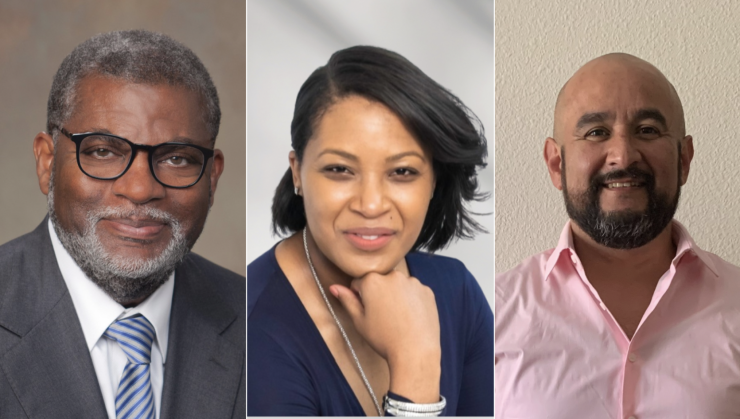Jessica Encarnacion's credit score was in the mid-500s when she left her partner about seven years ago, taking her son with her. The relationship, which was financially abusive, had wrecked her credit. She wanted to start her own business in Staten Island, where she lives, but the banks she looked at had high minimums to open a business account.
It wasn't until she joined the
"I was getting a lot of credit offers. I mean, it really made a difference," Encarnacion said. She eventually launched two small businesses with support from LES. Encarnacion, who identifies as a mixed-race person who is Afro-Latina, Caribbean, Caucasian and Native American, said another reason for her strong relationship with LES was her comfort with the staff there.
FDIC data shows that around
Credit unions see outreach to these demographic groups as important not only for membership growth, but also to provide services to consumers and small-business owners that feel they aren't properly served by mainstream financial institutions.
Breaking down barriers
Leading Edge Credit Union, with $146 million of assets and headquartered in Worthington, Minnesota, changed its name from
"The past two years, especially once COVID hit, we decided that now's the time to rebrand as we tried to focus more on things like DEI, on inclusivity, with all of our members. On all ethnicities, races, genders, we just want it to be all-inclusive," said Melissa Gehl, chief marketing officer at Leading Edge.

In Minnesota, where Leading Edge is based, "a huge majority of our members [are] Spanish speakers. English isn't their first language," Gehl said. Leading Edge hires bilingual interpreters to help members with their money, and has a robust referral system to educate immigrants on banking through partnerships with community agencies, she said.
"People who are struggling in the community can go into the local crisis center or to the helping center and then they, in turn, reach out to us because they know that we have bilingual employees employed, or that we're just kind of non-judgmental, we serve the underserved," Gehl said.
Leading Edge sometimes offers free presentations to educate Hispanic people at its community partner groups about personal finance in the U.S., with workshop topics ranging from banks versus credit unions, to using debit cards, to purchasing a first home. This organically leads to member acquisition. "It's nice because I don't have to spend a lot of those marketing dollars," Gehl said, adding that Leading Edge is frequently invited to do such presentations and it partners with local employers to recruit and hire new talent in town.
Pablo DeFilippi, executive vice president at Inclusiv Network and a former head of LES, sees a growing urgency to serve immigrant communities in light of the hardships brought on by inflation.
"Even middle-class people today can't afford to buy a car," DeFilippi said. Yet the need to drive for work is often essential to having a job, despite the recent shift to remote and hybrid offices.
"In rural communities and in many communities, [if] you don't have a car you can't work. Or if your car breaks, then you will lose your job. It's like a chain reaction, so having access to affordable cars is really important," he said. Credit unions that offer affordable car loans could make a big difference, he said.
They did for Cesar Cuevas, a 45-year-old bartender and son of immigrants from Mexico; his parents used only cash in America for years out of mistrust of financial institutions. After he joined the Mission Federal Credit Union, a $5.4 billion-asset credit union in San Diego, about eight years ago, Cuevas was quickly approved for a car loan at a low interest rate and has since bought three cars (one for himself and two for family members). His credit score was around 580-620 when he started at Mission, and as of this year it was 780. Mission is working with him to plan a future home purchase, he said.
DeFilippi also encourages credit unions to continue financing entrepreneurship among immigrants and racial minorities.
"Because of language barriers or because of job skills in industries that are more specialized, many immigrants actually start their own businesses," he said. "And that creates a huge amount of jobs. It helps revitalize communities, [yet] almost no mainstream lender makes loans to these communities."
Starting from within
Despite progress towards racial inclusion and
HOPE Credit Union, which is based in Jackson, Mississippi with $536 million of assets, is majority Black-owned and majority women-owned. Bill Bynum, the credit union's CEO, said this diversity can help guide crucial decisions such as where to place branches to best serve the local community.
"When you have a financial institution that is owned or managed by people of color, those institutions are more likely going to have branches in communities of color," Bynum said. "There are just not a lot of traditional banks, or traditional credit unions for that matter, that lean in and prioritize serving the communities that we serve at HOPE."
Data
Camesha Moody, a K-12 teacher in Mississippi who identifies as African American and banks with HOPE, said she had been trying for years to buy a house, but banks "had a lot of rules and limitations" that delayed the process. While her credit was good with a score of 711, Moody had been paying off large student loans, so many banks rejected her mortgage application. But HOPE called her back two hours after an initial phone screening and approved her for a mortgage, making Moody the first person in her family to be a homeowner. She moved into her home in 2019.
"The primary asset that most families own is their home," Bynum said, adding that accessing products like mortgages and business loans are how credit unions and banks can help close the Black wealth gap. In that regard, he said, "credit unions can do more to serve underserved people."







